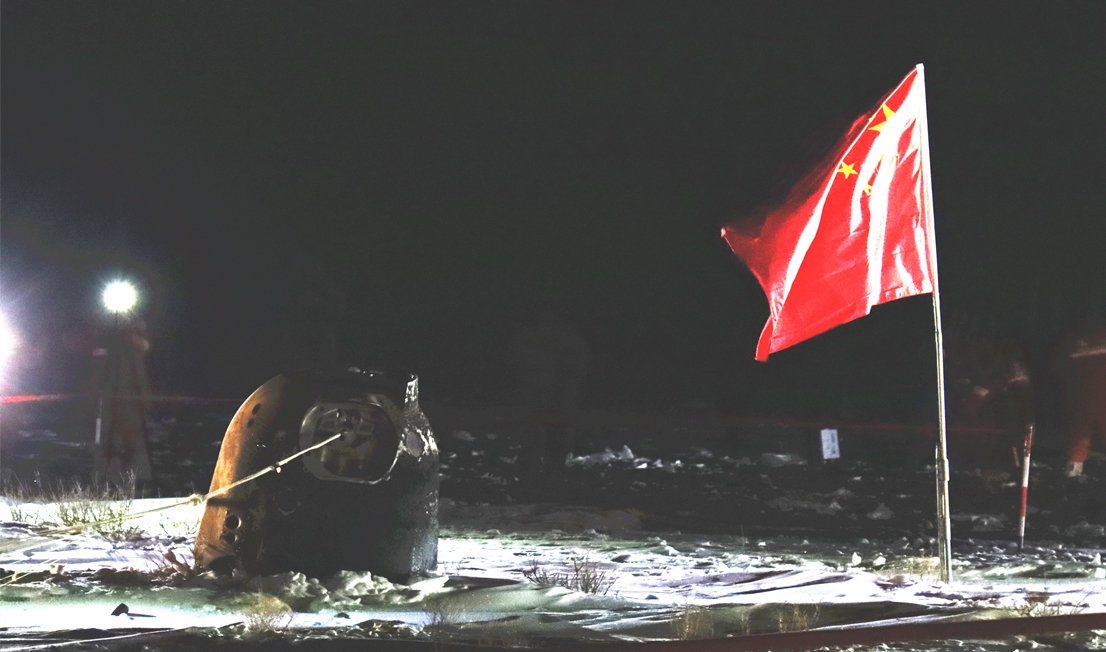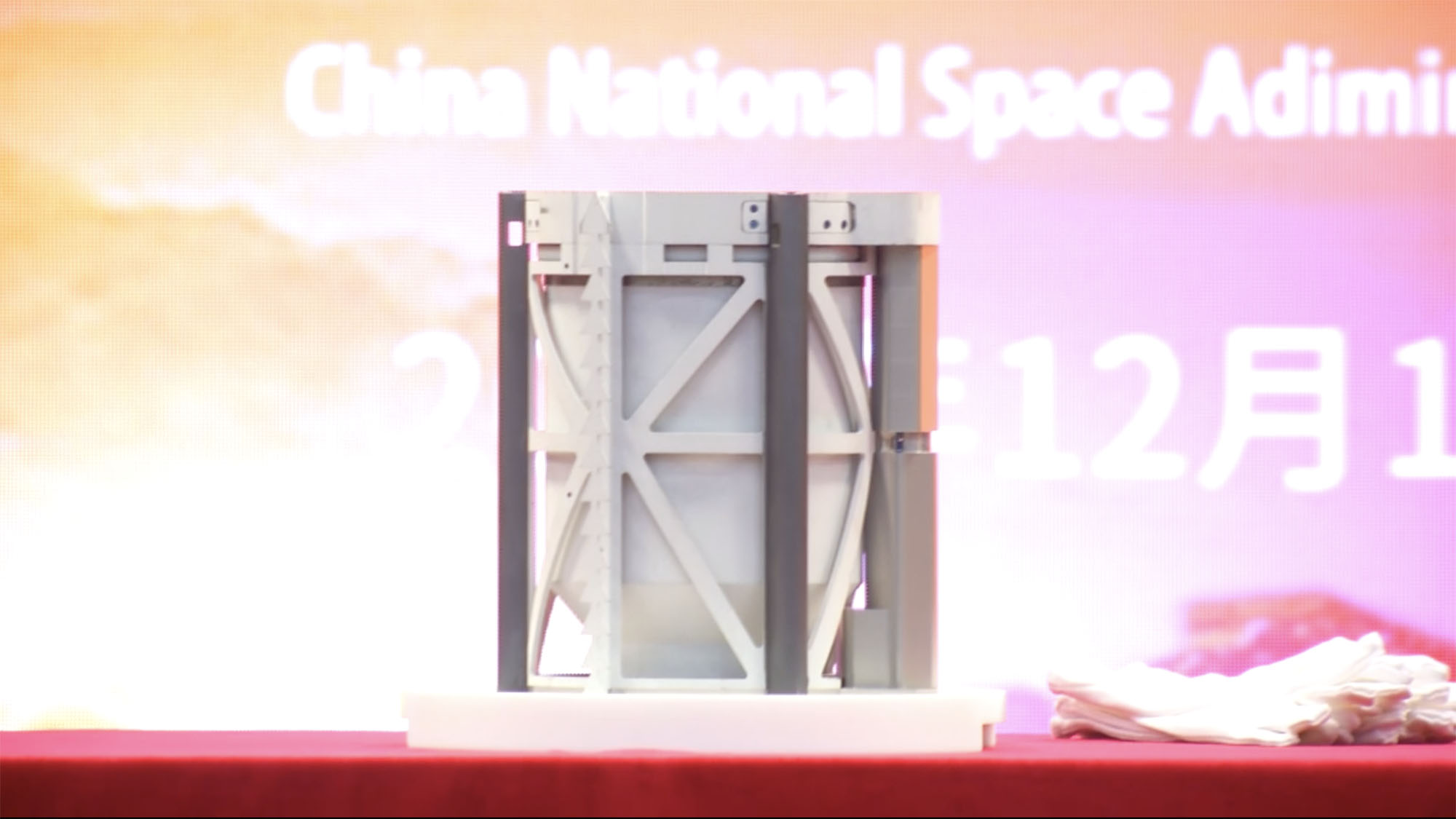China says it's open to sharing moon rocks as Chang'e 5 samples head to the lab
But U.S. space policy may bar American institutions from getting their hands on China's lunar samples.

China has recovered the lunar samples collected by the daring Chang'e 5 mission and now work is underway to get the materials to the laboratory for science — and for sharing.
The Chang'e 5 reentry capsule landed in Inner Mongolia on Dec. 16, marking the end of the 23-day mission. The capsule, still containing the collected samples, was then airlifted to Beijing.
The precious lunar materials were handed over for processing, analysis and storage at a specially designed facility belonging to the Chinese Academy of Sciences on Saturday, Dec. 19. The samples collected were found to weigh 3.81 lbs (1.731 kilograms) in total.
Related: China plants its flag on the moon with Chang'e 5 lunar lander
China's Chang'e 5 moon lander collected the material via a drill and a robotic arm, in the hard vacuum of the lunar surface.
The plan was to drill a 6.6 ft (2 meters) deep hole to collect 1.1 lb (500 grams) of material, with the scoop grabbing 3.3 lbs (1.5 kg). “However while the lander started drilling there, the radar echograms showed that there were several layers of slates underneath the landing site. So we were unable to go further down when we reached about one meter deep, and we could face greater risk and overrun the time if we did not stop immediately,” Hu Hao, chief designer of the third phase of China's lunar exploration program, told CCTV.
This is expected to be the reason for the samples collected being less than the planned 4.4 lbs (2 kilograms).
Get the Space.com Newsletter
Breaking space news, the latest updates on rocket launches, skywatching events and more!
Next, scientists have devised a special process to prevent the samples from being contaminated by particles on Earth.
"We will unpack the samples in a vacuum environment, and transfer them to a nitrogen environment for storage and processing," Zhang Guangliang, chief designer of the ground application system of the Chinese Lunar Exploration Project, told Chinese media.

As the samples can easily be contaminated, CAS has designed a clean room which will minimize the pollution from Earth particles, said Zhang. He added that the utmost care would be taken to get the most of the invaluable material.
"We will use the equipment with highest accuracy and take the smallest portion of the lunar samples in research to realize the maximum research efficacy of the sample," he added.
Li Chunlai, deputy chief designer of the Chang'e-5 mission, said in a press conference on Dec. 17, a day after the landing, that the rocks were collected from a site in Oceanus Procellarum thought to be of great scientific value in areas including space weathering, volcanism, the regional geological background and evolution of the moon.
"We will conduct long-term and systematic research on lunar samples in the laboratory, including its structure, physical properties, chemical composition, isotopic composition, characteristics of the minerals and the geological evolution behind the samples. We hope to deepen our understanding of the origin and evolution of the moon," Li said.
Related: The latest news about China's space program
Wu Yanhua, deputy director of the China National Space Administration, said in the same press conference that there would be three main uses of the samples: science, public outreach and sharing samples with other countries and scientists around the world.
Part of the samples may also be used as diplomatic gifts according to precedents set by the United States and Russia, Wu added.
However, the elephant in the room was the matter of cooperation between China and the United States. Asked if the samples would be shared with NASA, Wu replied that the "Chinese government is ready to share the lunar samples including relevant data with all like-minded institutions from other countries," but the matter of cooperating with NASA depends on U.S. policy.
"It has been unfortunate however after a Congressional act adopted in 2011 U.S. space institutions have been blocked from cooperating with China, which is the Wolf Act. On the basis of equality, mutual benefit and win-win cooperation we are willing to conduct sincere and friendly cooperation with U.S. institutions," Wu stated.
Wu also said that, in accordance with the Outer Space Treaty, outer space resources are the common asset of humanity. "We will act upon the relevant treaties," Wu said.
Notably NASA has said it will buy lunar samples collected by commercial space companies. The move is part of the Artemis program which aims to send astronauts back to the moon in 2024.
Follow us on Twitter @Spacedotcom and on Facebook.
Join our Space Forums to keep talking space on the latest missions, night sky and more! And if you have a news tip, correction or comment, let us know at: community@space.com.

Andrew is a freelance space journalist with a focus on reporting on China's rapidly growing space sector. He began writing for Space.com in 2019 and writes for SpaceNews, IEEE Spectrum, National Geographic, Sky & Telescope, New Scientist and others. Andrew first caught the space bug when, as a youngster, he saw Voyager images of other worlds in our solar system for the first time. Away from space, Andrew enjoys trail running in the forests of Finland. You can follow him on Twitter @AJ_FI.









